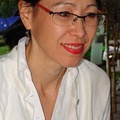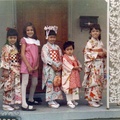Read part 2 >>
Now, to return to the issue posed in this forum’s prompt: in my case, I must try to find an instance in which both a generational difference and a national-cultural one revealed their criteria and influence. And there was a specific instance, an event I participated in several years ago, in 2004, for the “Japan Theme Day” at the Buenos Aires International Book Fair. I was invited together with an Argentine Nisei, Maximiliano Matayoshi, a talented young novelist who was then just over twenty. By this I mean to indicate that Maximiliano Matayoshi would pertain to the generation after mine. And on the national-cultural level, he is of course Argentine, one of those who have descended from the boats, as opposed to me, who only at the ripe old age of thirty-six could account for my “whole” identity on a national census form that finally allowed for multi-cultural individuals.
As part of our presentation, Maximiliano and I had a segment in which we asked each other about our identity—specifically about how much or little we felt that “being Japanese” was part of who we were.
I answered with irony. I stated that my name itself was proof of how hard—if not impossible—it was to move about “contemporary” (and here is where the generational pertinence acquires relevance) society with other cultures included in one’s identity. There was “Anna,” with its oddly multilingual and transnational quality; “Kazumi,” which sounds of course clearly Japanese but was often mistaken in the West as a surname; and then “Stahl,” with its unmistakable guttural German tone that contrasted bewilderingly with my Asian facial features. I recounted times when people—office receptionists, college professors, shopkeepers, postal workers, cashiers, government functionaries, etc.—had manifested their troubles trying to connect any combination of those names to my person. There was always a problem with at least one element, and people’s gazes would begin to flit back and forth between the identification document and my face, shadowy doubt visibly rising behind their neutral countenances. Innumerable times, I had been asked how I got those names—the assumption clearly being that I’d come by them in some inauthentic way (as regards the purposes of naming and identification)—and what therefore my real name was supposed to be. It was as if a mix of cultures as evidenced in Anna Kazumi Stahl simply could not be—“authentically”—a single individual’s birth-name.
To the Book Fair audience in Buenos Aires, I exhorted listeners to please remember that I was relating experiences that had occurred in what are customarily called the “advanced” nations: the USA, Japan, Germany, France, Switzerland, England…
In conclusion I mused that my identity could only be summed up as a site of conflict and confusion. Hence, as a person and as a writer, I abided, awaiting (impatiently) a time and a cultural conscientiousness whereby I and others like me would no longer be seen—whether at international borders or at simple shop counters—as persons so “marvelously full of holes” or as “inauthentically named”…
So the answer I gave to the question of my identity as a Nikkei contained that kind of tongue-in-cheek, barely veiled animosity about our current age’s mentality.
My co-presenter, on the other hand—and this is where the generational and the national differences make themselves palpable, relevant, and even revelatory—answered with no such aggravated yet still subdued critical maneuvering. Instead, he gave a simple list. Number one, he said, I am just me, in my most quotidian self, usually called by the nickname “Maxi.” Number two: I am a certain girl’s boyfriend, and that identity happens to be very important to me just now. Number three: I’m my parent’s son, a member of my family. Number four: I’m from the Caballito neighborhood in Buenos Aires. Number five: I’m a River fan (referring to the River-versus-Boca soccer rivalry that literally divides the city of Buenos Aires). Number six: I’m a writer; I tend to spend a lot of my time doing that, so I include it here in my identity. Number seven: I’m a student in the translators’ certification course. And here, around number eight or so, is where I’d place the reason I’m sitting here today speaking to this audience, yes, number 8: I’m Nikkei, meaning a person of Japanese descent. And being Argentine is even further down the list, for me really quite far towards the bottom. Because: how often do I think of myself in that specific sense? When I vote. And that’s not at all often…
As I listened to Maxi’s response to the question of his identity, I realized that it had not even occurred to him to consider the issue of a dominant hegemony of single identifying categories or any other such external logic. He was free in himself to give his own definition, willy-nilly. I was stunned and chagrined to see so visibly that I’d remained ensnared in a logic that I clearly did not consciously agree with, and yet that I continued to tango along with tightly as if there were no other tune, no other moves or steps to take. What a mishap!
Let me try to give another example of how enlightening it has been at times to live here in Buenos Aires and think about being Asian American. I know many Nikkei here in Argentina find themselves having to repeat over and over, “But I’m not Japanese.” Something similar used to happen not that long ago and all too often in the USA too: people would see certain ethnic features and blurt out, “What good English you speak,” as if unable to accommodate the idea of someone with an Asian appearance being a homespun native speaker of North American English.
What is interestingly different to me in the Argentine anecdote is that the exchange usually ends with “I’m not Japanese,” whereas the U.S. version usually closes with the emphatic retort: “I’m American.” It may be stretching things, but I’d like to allow myself the whim: I’ll venture that there is something worthy behind the idea that one would indicate the error, but not feel the impulsive reflex-reaction to have to offer an alternate yet equally totalizing identity formulation. One only senses a need to say “I am this” or “I am that” because one thinks one has to. Otherwise, and thinking more clearly now, there is no need to go in that direction and fit oneself into such small spaces. Because identity “outside the box” is not really contingent upon such narrow and fixed maneuvers. Hence, the artist working against the ideology of the single and immutable identity form has to find more complex forms of elaboration and expression.
How to think polysemically without carelessness. How to be aware of multiple facets, even mutually exclusive but simultaneously engaged facets, without frivolity and without a sense of tragic paralysis. Some of that paralysis hit me broadside when I was younger and first came across the writings of Carlos Bulosan or John Okada. Even the rage seemed to spurn and spin, only then to leave in its wake a paralyzing sort of stasis somehow. So too the mournfulness of Farewell to Manzanar. The work that kept coming back to me phase after phase of my development, my thought process about bi-cultural/multi-cultural identity formation, was Hisaye Yamamoto’s work; though the collection came out in the 1980s—and felt in tune with that generation’s less “Manichean” formulations—I have always been struck by the fact that many of the stories I found the most invigorating, the most mobilizing and enabling, were written decades earlier, shortly after WWII. I found in texts like “Yoneko’s Earthquake” and “The Legend of Miss Sasagawara” a certain kind of nimble, clear-sighted layering of divergent systems of meaning, all informing the narrative thread simultaneously (or each in its own time), and this kind of multi-layered thinking is, I intuit, the multi-cultural mind’s most fertile characteristic.
Of course the early published works’ documenting of a previously untold and occluded history of a subaltern segment is an irreplaceable effort and achievement. But the creative thinking, the innovation of forms that can encompass more than one cultural mindset at a time, was more nourishing and “productively provocative” for my young Asian American creativity.
Cynthia Kadohata’s The Floating World struck me as quick and committed in this same respect. The writing style itself, the aesthetic forms chosen, seemed to evince already a healthy renouncing of the easy and deceptive courses of identity formation even when they are meant to redress injustice. I recall an ongoing motif of traveling, of being in transit, and therefore of always having to stay engaged and able to register diverse resonances precisely because one had been displaced or even dismissed and had not yet found a new mooring or foothold yet. It seemed to go beyond the tragedy of injustice and, in weathering certain impasses, fashion a new way of telling, less “rooted” and yet more agile.
To me this kind of multi-layering and polysemically enabled capacity is a key not only to taking more aesthetic and formal risks but also to a certain mental training we must all undergo in order to further foster an evolving and newly flexible identity formulation (such as shown in the year 2000 census form). The historicity, the conscious inclusion of landscapes that speak historical memory, is paramount to my mind—Olivia Ann travels the roads of Arkansas, where her elders were interned; Miss Sasagawara has been taken to be mad but her poetry proves the awesome lucidity in her state. What I sense must be emphasized is that there is no mutual exclusivity in this thinking, in this writing—she is mad and she is lucid, they travel traumatized landscapes and they travel across a blank page, it is poignantly paralyzing and it is electrifying.
It strikes me that the best—the most clearly illustrative metaphor—is that of the pun. What is a pun? The very same letters in the very same order mean one thing, and they also simultaneously and with no repressing or neutralizing of the other significance mean another. (This type of language operation often elicits both rational and visceral responses, in that we react to puns and plays on words with a sense of righteously rational linearity, while at the same time we find ourselves opened to and engaging in another way of thinking, one based on the existence and excitement of irrational connections, subconscious associations, and even the unexpected appearance of prohibited or side-stepped elements of our lives. And is this not the very stuff of creativity at work? Not the logical sequence, but the unexpected combinations of anomalous, multifarious elements, which of course we recognize as incongruent, but which we also instantly sense as concretely able to coexist in our minds and lives.) The pun means both one thing and another thing, and indeed it also means that both can exist simultaneously, which may well be the more radical venture. And by inserting this as a metaphor here, I mean to say that multi-culturality is indeed not “marvelously full of holes” but rathermarvelously full of whole.
And I must add to that the dimension of an ethic that I most firmly believe in and depend upon: that of historicity, of responsibility to history.
In my writing and also in my teaching, I seek to remember history always, which is not to say that I’d preach any version of it. I hold to the conviction that by simply assuring there are spaces for the acknowledgment of historical events that have taken place—such as the stark quiet of those our parents and grandparents who sat in kitchens in Louisiana staring at checks signed by the President in the early 1980s—then history’s truths will persist and inform us and their consequential benefits be rendered unto us, for the better good, indeed—so I trust—for the general, collective good.
*This article was first published in The Asian American Literary Review Spring 2012: Generations. The AALR has generously shared several of the forum responses, poetry, and prose with Discover Nikkei from this issue by David Mura, Richard Oyama, Velina Hasu Houston, Anna Kazumi Stahl, Amy Uyematsu, and Hiromi Itō (translated by Jeffrey Angles).
AALR is a not-for-profit literary arts organization. To learn more about it or purchase a subscription to the journal, visit online at www.asianamericanliteraryreview.org, or find them on Facebook.
© 2012 Anna Kazumi Stahl






